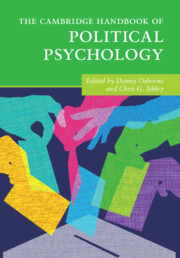Book contents
- The Cambridge Handbook of Political Psychology
- The Cambridge Handbook of Political Psychology
- Copyright page
- Dedication
- Contents
- Figures
- Tables
- Contributors
- Part I Foundations of Political Psychology
- Part II The Politics of Intergroup Attitudes
- 11 Authoritarianism
- 12 A Political Psychology of Ethnocentrism
- 13 Collective Narcissism
- 14 Demographic Change, White Decline, and the Changing Nature of Racial Politics in Election Campaigns
- 15 Macro-diversity and Intergroup Attitudes
- 16 The Persistence of Gender in Campaigns and Elections
- 17 The Politics of Abortion, Pregnancy, and Motherhood
- 18 Religiosity and Openness to Authoritarian Governance
- 19 The Consequences of Moral Conviction in Politics
- 20 The Political Psychology of National Identity
- 21 The Political Dynamics of Immigration Opinion Worldwide
- 22 International and Individual Differences in Support for Human Rights
- Part III Contemporary Challenges to Democracy
- Part IV Diversifying Perspectives in Political Psychology
- Index
- References
21 - The Political Dynamics of Immigration Opinion Worldwide
from Part II - The Politics of Intergroup Attitudes
Published online by Cambridge University Press: 17 February 2022
- The Cambridge Handbook of Political Psychology
- The Cambridge Handbook of Political Psychology
- Copyright page
- Dedication
- Contents
- Figures
- Tables
- Contributors
- Part I Foundations of Political Psychology
- Part II The Politics of Intergroup Attitudes
- 11 Authoritarianism
- 12 A Political Psychology of Ethnocentrism
- 13 Collective Narcissism
- 14 Demographic Change, White Decline, and the Changing Nature of Racial Politics in Election Campaigns
- 15 Macro-diversity and Intergroup Attitudes
- 16 The Persistence of Gender in Campaigns and Elections
- 17 The Politics of Abortion, Pregnancy, and Motherhood
- 18 Religiosity and Openness to Authoritarian Governance
- 19 The Consequences of Moral Conviction in Politics
- 20 The Political Psychology of National Identity
- 21 The Political Dynamics of Immigration Opinion Worldwide
- 22 International and Individual Differences in Support for Human Rights
- Part III Contemporary Challenges to Democracy
- Part IV Diversifying Perspectives in Political Psychology
- Index
- References
Summary
Research exploring public opinion dynamics in the domain of immigration has exploded in recent decades, and for obvious reasons. Policy debates in developed democracies have intensified as barriers to movement fell in Europe and the USA and as populist leaders began to capitalise on, if not stoke, public anxieties about the influx of newcomers. A central question is why some individuals are so much more willing than others to allow immigrants into their country, and the debate has centred primarily around real economic consequences versus deep-rooted group identities and animosities. Given all the welcome attention to this fundamental question, we can only review a small slice of this burgeoning literature. To these ends, we provide a broad overview of the impact of real immigration contexts, economic versus symbolic group attachments, and the role of the media and elites may play in triggering either or both forces by triggering powerful emotions. Since these explanations are so difficult to causally untangle, and since the literature has focused so much on the USA and a few other countries, we pay special attention to recent, comparative research that goes beyond simple observational designs.
- Type
- Chapter
- Information
- The Cambridge Handbook of Political Psychology , pp. 329 - 345Publisher: Cambridge University PressPrint publication year: 2022
References
- 1
- Cited by



